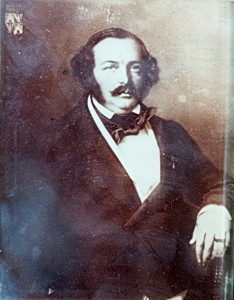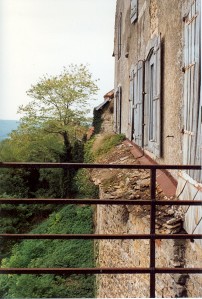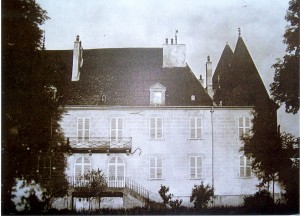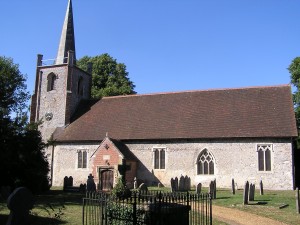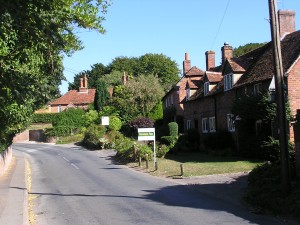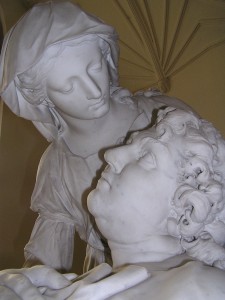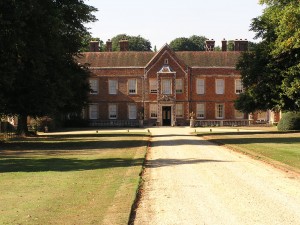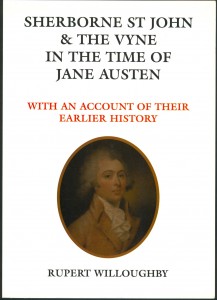L’invention du crayon «de plomb» est créditée aux Anglais en 1564. L’inventeur du taille-crayon était un Français, Thierry des Estivaux. À Paris en 1847, il fait breveter sa conception du tube classique équipé d’un cône qui rétrécit et d’une lame. Il s’agissait d’une invention qui a sauvé les doigts de générations d’écoliers, qui auraient dû tailler la pointe de leurs crayons avec leurs canifs. Il s’agit d’un objet qui est universel et pris pour acquis.
Constant de Thierry des Estivaux était un vaillant officier et patriote. Celui-ci est né à Paris en 1797, le fils aîné du colonel Gaspard de Thierry, baron des Estivaux en Lorraine, le commandant fringant des 9e hussards pendant les guerres de la Révolution, et sa belle épouse Romarine, comtesse de Faletans et Digoine, une franc-comtoise.
En 1814, alors qu’il était encore écolier, Constant participait à la défense de Besançon, et en 1815, âgé de 17 ans, combattait aux côtés de son père à la bataille de Waterloo, d’où cinq blessures. Il servit ensuite dans les dragons de Besançon et, à partir de 1822, dans l’armée russe, en tant qu’aide-de-camp personnel de son «oncle», le général comte de Langeron. L’un des grands hommes de son âge, Langeron avait sauvé la vie du duc d’York, le «grand vieux», combattit les Turcs sous Potemkine et commandait une division à Austerlitz. Un parent éloigné, il traitait Constant comme son propre fils.
Constant quittait la Russie après la mort de Langeron en 1831, avec l’intention de s’installer à Paris. Il est arrêté à Briançon, à la frontière française, apparemment sur les ordres d’Adolphe Thiers, le ministre de l’Intérieur. Ses bagages, contenant des documents volumineux de Langeron, ont été saisis. Les documents sont éventuellement placés au ministère des Affaires étrangères à Paris, et dont diverses parties ont depuis été éditées et publiées. Sans toujours l’avouer, Thiers tire pleinement d’eux dans son Histoire de l’Empire (publié dès 1845), duquel, à son tour, son livre fournissait Tolstoï avec beaucoup de son matériel de base pour la Guerre et la Paix (publié dès 1868). Le récit de Langeron du briefing de Weyrother avant la bataille d’Austerlitz constitue la base d’une scène particulièrement mémorable (Livre III, chapitre XI). Tolstoï le fait jouer avec une tabatière en or, tandis qu’il écoute les inanités de Weyrother, un sourire ironique sur son visage alors qu’il tente de piquer sa vanité. Langeron, que Byron avait déjà évoqué flatteusement en vers dans Don Juan, n’aurait pas été mécontent.
Autant que l’on sache, Constant ne devait plus jamais être officiellement employé. Au lieu de cela, il a essayé sa main comme inventeur. Il brevetait une de ses inventions en Angleterre en 1839, et, pour aucune raison particulière utilisait le pseudonyme de «Morillon». Le 21 Avril 1846, il brevetait, cette fois-ci en France, sa conception d’un «propulseur palmipède propre à la navigation maritime et fluviale». Sa tentative d’améliorer la propulsion nous fait penser au «pyroscaphe», le bateau pionnier avec des rames équipées de lames rotatives propulsé à la vapeur, inventé par son parent âgé, le marquis de Jouffroy d’Abbans, et testé sur le Doubs à Beaume-les-Dames en 1776. À la retraite au château d’Abbans-Dessus (Doubs) dès 1816 Jouffroy d’Abbans était un proche voisin des Faletans (ces derniers s’étaient retirés pendant les périodes troublées dans leur propre château de Busy); transférait-il, peut-être sa passion pour l’ingénierie au jeune Constant. Jouffroy d’Abbans avaient reçu peu de récompense ou de reconnaissance pour son invention, et décédait comme retraité nécessiteux dans l’Hôtel des Invalides, en Juillet 1832. Si Constant ne s’est pas ruiné positivement par ses efforts, de même, ils ne lui ont guère enrichi.
Constant de Thierry des Estivaux a été autorisé à ajouter à son patronyme celui de sa mère, de Faletans, par décret en 1851, et en 1863, après s’être installé au Château de Faletans (Jura) a été créé marquis de Faletans en tant que représentant de la famille marquisale de Faletans, dès lors éteinte. Il était mon arrière-arrière-arrière-grand-père. Jusqu’à tout récemment, je n’avais aucune idée qu’il était l’inventeur du taille-crayon. C’était surement sa plus belle réussite, mais, malheureusement, celle-ci n’est pas la base d’une fortune familiale. La production en masse de crayons date de la fin du 19e siècle. La demande énorme et continue des crayons, pour les écoles et les bureaux, a décollé dans les années 1900. Constant, lui, est mort en 1871. Il mérite d’être mieux connu.
Mon histoire de la famille, The Incredible Journey of Victor Hugo’s Dog, est en préparation: http://www.rupertwilloughby.co.uk/books.
(This blog was originally published in English in July 2011: see http://www.rupertwilloughby.co.uk/archives/683.)
